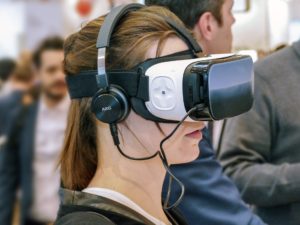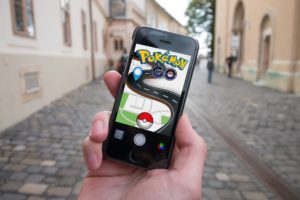Virtual Reality (short: VR) and Augmented Reality (short: AR) have entered most business branches virtually with light speed. Nonetheless, VR and AR also include some more expensive equipment and a lot of editing effort. So, like with every new technology, everyone must find out if VR and AR are relevant enough for one’s business to invest all this time, work and money.

VR and AR – basic information and distinctions
Everyone watches videos- either in the “classical HD quality” (codec: H4.264) or in a brilliant HEVC format (codec: H5.265). However, most people still consume videos on screens without diving deeper into them or even re-creating them. So here come Virtual Reality (VR) and Augmented Reality (AR) for an even more intriguing vision of virtual contents and worlds! In many cases, VR and AR are not only “fun stuff”, but can take a very useful role in marketing, event management, production lines and business.
But first things first: There are some major distinctions between Virtual and Augmented Reality. In order to enjoy Virtual Reality, you need some special devices like VR glasses. Furthermore, you can move through virtual spaces while the VR device tracks your eye and head movements. Nonetheless, the viewer remains in the role of the recipient and does not change the virtual environment.
This is different with Augmented Reality. According to the degree of freedom (DOF 3 or 6) assigned to the consumer, users can move freely through virtual worlds or connect them with the “real world” around them. Unlike in Virtual Reality, they do not even need any special AR devices. It’s enough to use a smartphone or a tablet. Naturally, in some environments, AR glasses can also be helpful. There’s one more aspect to Augmented Reality. You cannot only visualize things, you can also shape them “to your own devices”.
Useful VR and AR matches in business
Probably, one could spend hours now to explain the technical background of AR and VR. But all these details deserve at least one more article in social media. So let’s get back to the overall topic: Which branches and occasions can profit from a “virtualized” business environment?

Home and garden design
Just imagine how easily you can create your dream garden or green places in your company on a tablet with drag-and-drop elements! Maybe you are even a professional gardener or landscape architect who conducts landscaping projects for both B2B and B2C customers. In this case, a VR or AR design solution is a great opportunity for your customers to visualize what they really want. Creating “virtual realities” is also helpful for interior designers, so they can satisfy their customers’ wishes more precisely and easily.
Real estate and construction
Let’s stick with home and garden for a moment. In general, renting, selling or buying a house or apartment always requires a match between the providers and the interested party. One note to all estate agents reading this … Wouldn’t it be nice to attract only those potential buyers whose goals match the “built-in reality” of the second-hand object you want to sell or rent? Then, transparency from the beginning is your key to success and creates a win-win situation. AR and VR perspectives of houses and apartments, like a virtual 360° tour online, might make your “perfect match” curious for a real appointment.
The other common option in the real estate sector is planning and building a house from scratch according to one’s individual wishes. Those who assigned an architect a few decades ago probably still remember “paper only” site plans with handwritten numbers all over the big sheet. These days, you can simulate the entire construction process via AR devices and special software. In the end, you can also check the virtual vision of the planned building. Exact digital planning makes it easier to estimate the time span and costs of construction. Furthermore, this way, you can avoid misunderstandings and disagreement between the future house owners and their construction company.
VR and AR for virtual showrooms and events
Is there an important trade show or congress ahead? Do you need to present your company and products and do you want to impress your potential business partners or customers? VR and AR solutions can help you in many ways. For example, you can completely bring your company presentation to life with a virtual tour and surprising three-dimensional effects or simulate your product’s functions with AR tools. As virtual events have been on the rise for the last few years, AR and VR have become important event marketing aspects.
By the way: You needn’t schedule any events in order to profit from augmented reality simulation, playful and interactive product design or a complete virtualized showroom. Your co-workers and customers love easy solutions and nice surprises wherever they are!

Gaming and entertainment with VR/ AR devices
Although many branches are currently virtualizing their customer journeys and user experience, one cannot deny that the sectors of gaming and entertainment clearly are pioneers in the field of AR and VR. As games and movies are usually designed as virtual or even virtually connected “parallel spaces”, it just seems natural that VR and AR have been a part of these industries for a long time.
Blockbusters in 3D cinemas, interactive sports games (e.g. FIFA) and Pokémon Go are only three well-known examples. Fun fact: The entertainment branch includes the Adult Entertainment Toys and movies. Consequently, connected sex toys and interactive porn content (PoV- “Point of View”) also require technical elements used in Virtual Reality and Augmented Reality.
Virtual clothing and accessory shops
We all know the eternal cycle of paying, buying, selling and – well, returning things that are defective or do not fit our expectations. How much easier could life for buyers and vendors be if one would find the right clothes and accessories without “return to sender”? And how many resources could online vendors save with less returned shipments? At this point, AR and VR tools can offer your customers a very good service to find what really fits them and what they like to wear on their bodies.
Some potential real life scenarios for this new customer journey:
- Your shop as a virtual online showroom;
- possibility to create a realistic avatar with one’s physical features and measurements;
- option to “play” with the colours and designs of accessories and to zoom into different sectors of the virtual environment and avatar;
- automatized recommendations based on selected items and measurements;
- 3D pictures of your flagship products.
By the way, the idea of a virtual shop environment based on AR and VR technology is not only valid for clothing and accessories. Vendors of home style products or furniture can profit from an attractive virtual showroom in the same ways.
VR/AR simulation of machines
Explaining and visualizing complex industry machines for a non-expert audience often becomes a big challenge. Especially Augmented Reality technology can be a helpful game changer to create a less abstract and more “touchable” impression of how your machines work on the inside.
With VR and AR tools, you can let your co-workers and trade partners explore complex technical functions in their own time and with their own focus. So you can hand them the tablet or remote control without risking any real damage on the machine. Generally, on a virtual level, you can simulate machines everywhere you go – be it in your own production site or at a show booth.

360° exploration in the tourism branch
WYSIWYG – “What you see is what you get”. This principle does not only count for IT user experience, but also for other sectors of life. Booking holidays on the internet is a typical WYSIWYG example. There’s an urgent need in human beings to see, compare and know an offer before accepting it. Here’s what everybody in tourism or travel marketing should keep in mind … For most travellers (which also means: customers) going on holiday is always an “adventure”.
No wonder as they leave their “safe cave” and comfort zone in order to satisfy their curiosity and need for exploration. In any case, they want to feel a certain safety about WHERE they are going and WHAT things will be like there. This is why people read recommendations and check other people’s ratings very precisely. As they pay for their personal “time of the year”, they want to make sure to get the best possible option.
With AR and VR elements in your tourism marketing, you can wake your customers’ interest and make your offer a safe choice. Here are some ideas for virtual marketing tools:
- 360° tours through hotels , apartments and campsites;
- virtual exploration of the environment, e.g. popular sights, beaches or landscapes;
- interactive maps of your campsite or resort or of the environment, maybe in realtime;
- a virtual avatar leading the viewer around.
Medical sector and pharma industry
In the medical and pharmaceutical sector, you normally can’t “see through” a patient’s body and distinct its functions. Here’s where VR and AR can help. Especially Augmented Reality tools can simulate or visualize “invisible” processes. For example, you can create an AR body scheme and present in an interactive 3D video how pharmaceuticals work within this artificial body. Furthermore, you can dive deeper into radiographs and sonograms – be it a static picture or a “motion picture from the inside”.
Also in medical education, research and check-ups, VR and AR perspectives can create understanding, transparency and trust. When relying on sensitive video data, always respect and protect your patients’ and content providers’ data privacy.
Automotive, ships, rail traffic and aviation
It’s obvious: The transport automotive and transport sector offers a lot of scenarios for VR and AR simulation. For example, you can
- make flight and ship simulation even more realistic;
- check and present big machines and complex motors without transporting and opening them;
- simulate machine operations and let your audience or co-workers “get in touch” with the machine core without risking any damage;
- find potential error sources within a motor or machine a lot easier;
- virtually testing machines In risky situations for a first estimation;
- check and simulate new railway routes in order to avoid unnecessary costs;
- save costs by designing motors and machines virtually before purchasing and setting up any physical components;
- contribute to safer test scenarios for self-driving vehicles.

Marketing: close-up effects with VR and AR perception
The more players there are on the global markets, the more creative your marketing and product presentation strategy has to become. This means that you need to provide your potential customers with something that catches their eyes – and ears.
In the VR and AR field , this could be
- deep dive into your videos with a 360* perspective;
- an impressive virtual video presentation at your show booth or in a showroom;
- “touchable”, interactive products for customers and visitors to play with;
- AR design and customizing via remote control or touchscreen;
- many more possibilities mentioned in the paragraphs before.
Remember: Whatever you do and whatever you want to sell, every presentation of products and services is a part of your marketing strategy.
Digital teaching and learning spaces
Virtual learning spaces have taken a crucial role since the pandemic peak in 2020. However, this critical period of drew a very clear picture of many schools and learning institutions that weren’t exactly prepared for fully digital learning structures. So there’s still some “digital homework” to be done as remote work and remote learning stay on the rise.
For example, one could create a wider array of customizable virtual spaces with VR and AR tools. In general, Zoom and other conference platforms only rely on two-dimensional communication and media. 3D spaces are more interactive and make both the teaching and the learning members of the group feel more connected. Plus, it is more fun to learn and teach in a customized “safe space” which you can rely on from a technical point of view and which you can adapt according to your requirements.
Also in university research and professional education, remote seminars and the virtual presentation of instructional content can add an extra value to on-site learning. Furthermore, VR and R videos make students feel closer to the objects of interest and happenings. For example, you can use virtual reality content during History, Physics or Biology lessons. Also museums and other cultural hotspots can create digital learning spaces to attract curious visitors.

VR and AR: extra dimensions to the “real world”
Talking about virtual and augmented reality tools, one finds a lot of scenarios for this helpful tech sector. Nonetheless, VR and AR can never replace what we call “the real world”. This is the world in which you talk to your family, friends and colleagues without wearing headphones. It is the informal chat in the coffee machine queue after lunch, the feel of leaves under your shoes and your child leaning at your shoulder half asleep. There are probably millions of examples that make the physical and “analogue” world unique.
Also in business, some branches absolutely rely on the personal eye-and-touch contact. Consequently, AR and VR might not be the (only) right way to go there. Find some examples for in situ branches here:
- hospitals, doctor’s offices, hospices, special care homes and therapeutic offers;
- child care, day care, schools (especially primary schools);
- children’s homes, refugee relief, on-site NGO work;
- waste management, catering, cleaning services, skilled craft and trades, hairdressers and similar businesses;
- artists and authors who depend on live shows, live events and “real touchpoints”;
- in a nutshell, “hands-on” branches in which you can use VR and AR for marketing purposes only.

Ein Gedanke zu „VR and AR: business boosters?“
Kommentare sind geschlossen.

[…] toys. Just think of animated movies created by artificial intelligence according to human standars, VR and AR games and content and automatic toys like the Sony Aibo robot […]